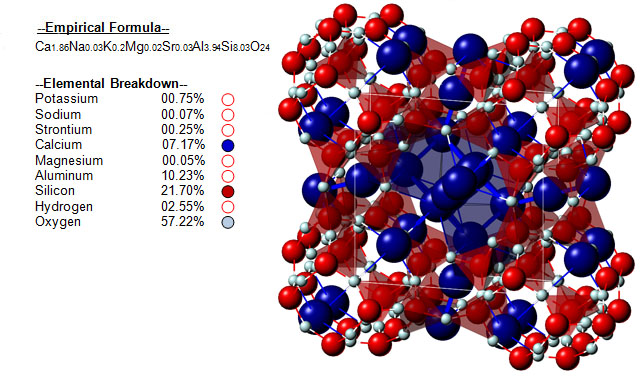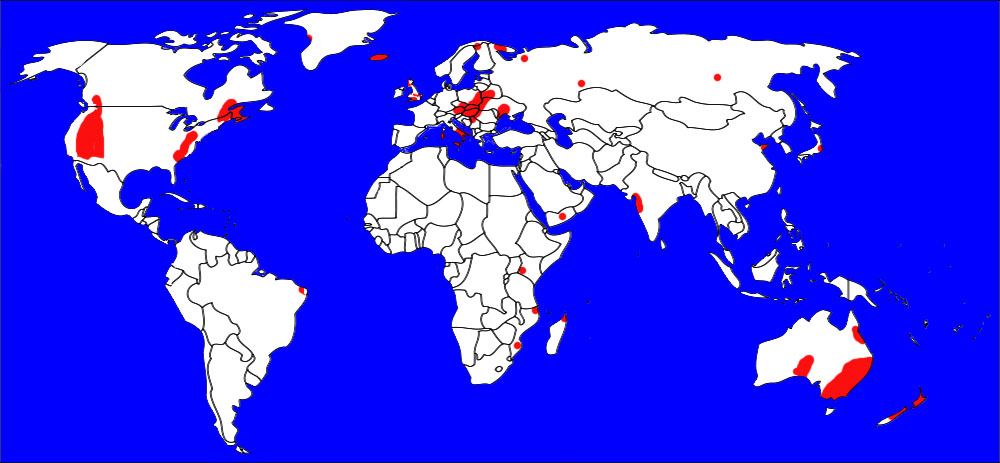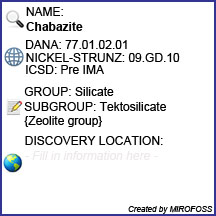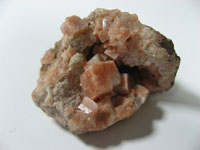![]()
Chabazite is one of the rarer tectosilicate minerals of the zeolite group. Chabazite is closely related to gmelinite. Recognized varieties of Chabazite include Chabazite-Ca, Chabazite-K, Chabazite-Na, and Chabazite-Sr, depending on the prominence of the indicated cation. The name chabazite comes from the Greek word 'chabazios' which means a tune or melody. Chabazite is one of the twenty stones named in the poem "Peri lithos", which extolled the virtues of minerals. The poem is ascribed to Orpheus, legendary founder of the Orphic cult, which flourished in Greece in the early centuries. Chabazite is found in India, Iceland, the Faroe Islands, the Giants Causeway in Northern Ireland, Bohemia, Italy, Germany, along the Bay of Fundy in Nova Scotia, Oregon, Arizona, and New Jersey. It was named chabasie in 1792 by Bosc d'Antic and later changed to the current spelling.
![]()
Within the metaphysical realm of minerals, chabazite is said to be a good material for meditation on the theme of Mother Earth. Chabazite can help bring structure to a persons life and allow the intellect to adjust to a higher realm to stimulate higher learning. Chabazite can also help to aid in removing addictive habits and behaviors. Some cases, chabazite helps people to take control of their life; enhances ones endurance, perseverance, and tenacity.
Please note that MIROFOSS does not suggest in any way that minerals should be used in place of proper medical and psychological care. This information is provided here as a reference only.
![]() Chabazite is used, like other zeolite minerals, as a chemical filter. Chabazite is also a sought after collectors mineral.
Chabazite is used, like other zeolite minerals, as a chemical filter. Chabazite is also a sought after collectors mineral.
![]()
Chabazite occurs most commonly in voids and amygdules in basaltic rocks.
![]()
Chabazite crystallizes in the triclinic crystal system with typically rhombohedral shaped crystals that are pseudo -cubic. The crystals are typically twinned, and both contact twinning and penetration twinning may be observed. Chabazite can be found in many colours such as white, orange, brown, pink, green, yellow, or even colourless.
Other than in the basic mineral form, chabazite can be found in one distinct variety. However, chabazite is generally referenced as a series of minerals rather than one specific mineral. There are five known types of chabazite. Chabazite-Ca, Chabazite-K, Chabazite-Mg, Chabazite-Na, Chabazite-Sr. Each element at the end of the name classifies an abundance of the element as an end member to the mineral.
![]()
| Cleavage | Imperfect | |
| Colour(s) | Colourless, green, Yellow, White, Pink, Brown, Orange | |
| Specific Gravity | 2.09 | |
| Diaphaneity | Transparent to Translucent | |
| Fracture | Brittle, uneven - Very brittle fracture producing uneven fragments. | |
| Mohs Hardness | 4.0 | |
| Luminescence | Non-fluorescent | |
| Luster | Vitreous (Glassy) | |
| Streak | White | |
| Habit(s) | Druse to Pseudo Cubic | |
| Radioactivity | Chabazite per GRapi unit = 9.03 (%) | |
| Magnetism | Non-magnetic |
![]()
The following health hazards should be noted when handling chabazite
 |
RADIOACTIVE Chabazite is radioactive as defined in section 49 CFR 173.403. Greater than 70 Bq / gram. |
![]()
The following image shows the Elemental breakdown of the mineral chabazite along with the mineral crystal structure.

![]()
| Crystal System | Triclinic |  |
| Class | Pinacoidal | |
| Axial Ratios | a : b : c = 1.001 : 1 : 0.9957 | |
| Morphology | pseudorhombohedral crystals, tabular | |
| Optical Data Type | Biaxial (+/-) | |
| Pleochroism (x) | None | |
| Pleochroism (y) | None | |
| RL Values | nα = 1.478 - 1.487 nβ = 1.480 - 1.490 nγ = 1.480 - 1.493 |  |
| Max Birefringence | δ = 0.002 - 0.006 (See colour chart at right) | |
| Surface Relief | Moderate | |
| Dispersion | None | |
| Notes | If uniaxial, commonly shows birefringent panelling in six sections. |
![]()
Chabazite can be referenced in certain current and historical texts under the following ten names:
The mineral chabazite can be translated into the following select languages:
| Arabic | Bulgarian | хабазит | Chinese (Sim) | 菱沸石 | |
| Croatian | Czech | chabazit | Danish | chabazit | |
| Dutch | Chabaziet | Esperanto | Ĥabazito | Estonian | |
| Finnish | Kabasiitti | French | chabasite | German | Chabasit |
| Greek | σαμπαζίτης | Hebrew | Hungarian | Chabazit | |
| Italian | Cabasite | Japanese | 菱沸石 | Korean | 캐버 자이 트 |
| Latin | Lithuanian | Norwegian | chabazitt | ||
| Persian | Polish | Chabazyt | Portuguese | ||
| Romanian | Russian | Шабазит | Slovak | Chabazit | |
| Spanish | Acadialita | Swedish | chabazit | Tagalog | |
| Turkish | sabazit | Ukrainian | шабазіт | Vietnamese |
![]()
Chabazite can be found in many places around the world. The map below shows major documented concentrations of chabazite:

![]()
 |
The MIROFOSS database offers free printable geological identification tags for personal and non-profit use. These tags can be used to properly identify mineral samples in your collection. -Click here- to download a full size jpeg image for a chabazite identification tag; which can be printed on paper or used with a plastic laser printer. |
 |
What's this? What can I do with it? |
![]()
| History | Neuhoff, P.S., J.F. Stebbins, & D.K. Bird (2003), Si-Al disorder and solid solutions in analcime, chabazite, and wairakite: American Mineralogist: 88: 410-423. |
| Chemical Composition | Zema, M.; Tarantino, S. C.; Montagna, G. (2008): Hydration/dehydration and cation migration processes at high temperature in zeolite chabazite. Chemistry of Materials 20, 5876-5887. |
| Geographical Data | Mindat.org. Retrieved on 2012-11-14 |
| Physical Identification | Webmineral.com. Retrieved on 2012-11-14 |
| Metaphysical Properties | Crystal Power, Crystal Healing: The Complete Handbook" by Michael Gienger |
| June 25, 2014 | The last time this page was updated |
| ©2017 MIROFOSS™ Foundation | |
 |
|






